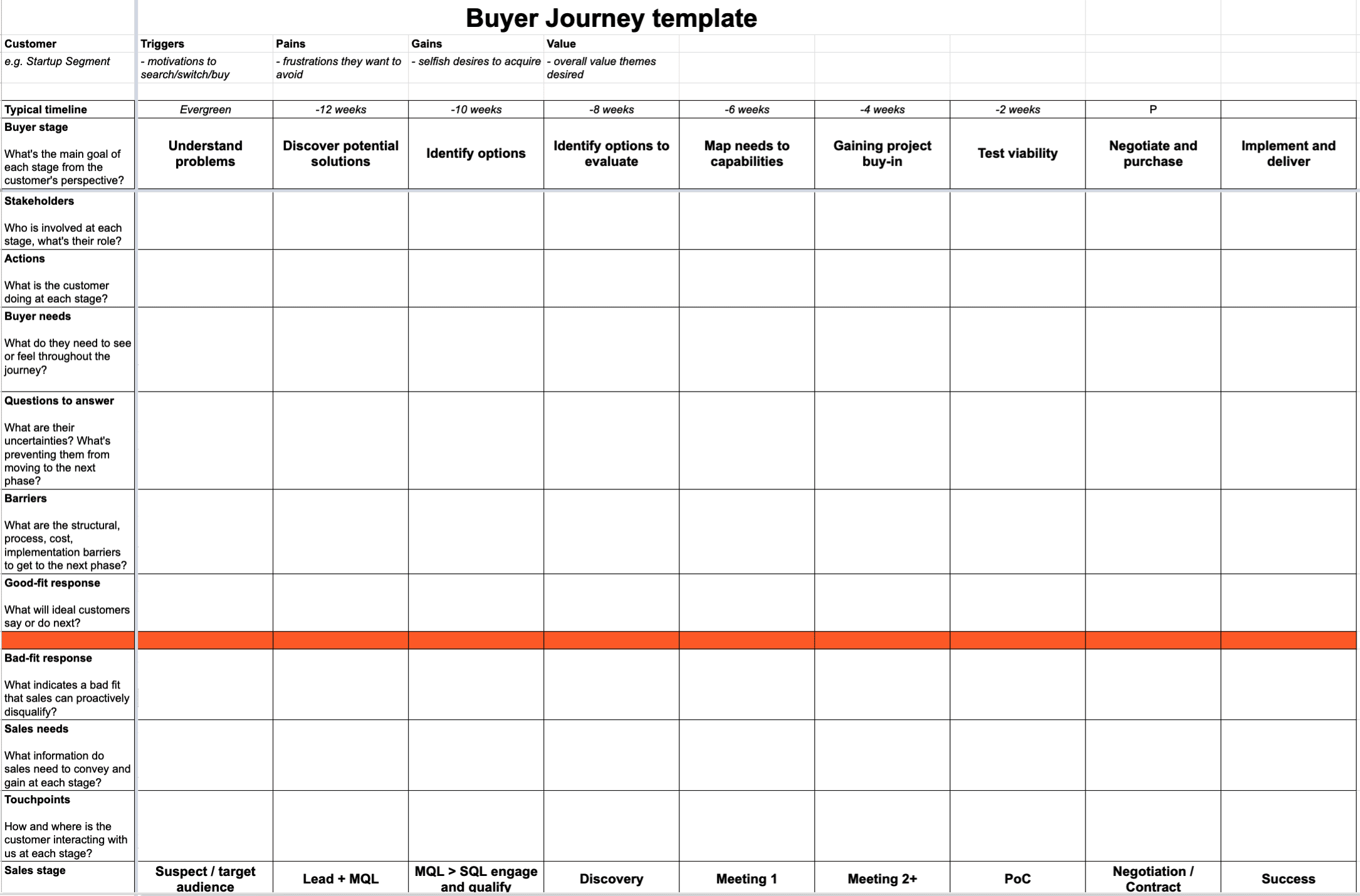Hi, I’m James. Thanks for checking out Building Momentum: a newsletter to help startup founders and marketers accelerate SaaS growth through product marketing.
Does any of this sound familiar?
“We need to send a one-pager!”
“The customer requested an overview deck before we meet.”
“They asked us to send some information over to see if they’re interested… what do we have?”
A PDF is thrown together with a few days delay whilst it’s designed in the brand colors. Or a custom Frankenstein deck is created from the other relics that clog up the Google Drive shared folder.
Maybe somebody clicks, and it piques interest enough to get that meeting booked. But who really knows?
¯\_(ツ)_/¯
This whole rigamarole is inefficient and ineffective, yet it’s still expected by prospects and sales reps, and so duly delivered by whoever is responsible.
Unfortunately, it’s extremely likely that the sales collateral has been created just because somebody asked for something. The end result is disconnected from the buyer journey, confusing the prospect or muddying the waters even further.
Sales collateral is material specifically developed to engage a prospect with the information they need, in order to close the deal faster.
Most sales collateral ignores the buyer and what they need from their process and instead chooses to shout about the company or product. Whitebooks on proprietary technology and algorithms, case studies about the implementation process, or ROI calculators that are not at all one-sided.
Often, sales reps can use collateral as a crutch to hang their outreach and engagement on. I’ve seen too many reps send the overview deck in the first cold outreach email, or use a one-pager with a wasted call-to-action of “let me know if you’re interested in finding out more”.
In this post:
What makes good sales collateral?
In an alternative world, sales collateral comes from a solid understanding of your buyer’s journey – which comes from a solid understanding of who your ICP is and what’s going on for all your personas.
A solid buyer journey
The buyer journey is well-documented, highlighting and prioritizing what they need the questions they ask at each stage in the process. This aligns with your internal sales process, mapped to stages in the funnel.
Each stage of the buyer’s journey has been analyzed to understand what the buyer wants to know and should know by the time they move onto the next stage. This is then aligned into key sales activities at each stage – your discovery call, meeting one, demo, and so on.
Purposefully crafted collateral
The sales collateral available at each stage has been created proactively, in preparation to both answer questions should they arise, and also carefully crafted content to push the deal forward. This might be through case studies to build trust, interactive demos for workflow exploration, or a short video that walks through key topics. Each sales rep has a playbook of collateral they can deploy to answer specific questions and achieve specific outcomes.
Collateral generates insight and actions
The usage of sales collateral is linked to each prospect, and provides further information to help the rep navigate through the opportunity. Did they open it, share it, engage with it?
This alternate universe sounds great… but is probably unattainable, right?
Not quite. Here are three steps to help you understand your buyer journey, identify opportunities for effective collateral, and create content that helps deals close, faster.
Step 1: Understand your buyer journey
This is really key to many parts of your Go-To-Market strategy, but is complex to develop.
Every single person you speak to – from buyers, champions, to sales reps, and subject matter experts – will describe their buying process both wildly differently and completely unhelpfully. They were (and are) so enveloped in the process, they’ll find it hard to step back and look at the big picture.
Map your internal understanding
Start with your sales process map, and interview your top sales reps to understand what buyer needs, questions, and sales needs exist at each stage.
Create a simple spreadsheet and sanity check with other reps. Ask them to highlight the insights they have experienced themselves, the insights they’ve experienced that are in the wrong stage, and to remove anything that they have not experienced. This filtering helps you identify patterns that exist, those which need to be better understood, and pieces which may not be common.
Use call recordings and email comms to try to provide some evidence behind the buyer questions and needs you’ve identified, and ask questions to adapt as required.
This will get you to something that looks roughly correct. But now we need to find a way to discover our unknown unknowns.
Use and validate with outside insight
Ask ~3 customers to describe a) how they purchased a similar product like yours, and b) how they purchased your product – and record all the notes.
Look for patterns and compare the key questions and needs they identified to those discovered in your internal research.
Select some friendly customers and prospects to take part in a card-sorting exercise. Here, you’ll randomize the buyer needs and questions into ‘cards’, and ask buyers to group them along a process, before naming each step of the process. You’ll get a few different versions, so you’ll need to use your own insights to finalise them, but you’ll end up with something that is much stronger than having a guess yourself.
Document your buyer journey
Make sure you document your buyer journey in an easy-to-understand format.

Step 2: identify sales collateral opportunities
Now that your buyer journey is documented, you’ll have a good idea of the buyer needs and questions that arise at each stage of the journey. So how do you use this to understand where your sales team need collateral support?
Map your current deals
The easiest way to start is by mapping your current pipeline to the buyer journey. Where is each prospect, what questions have not been answered yet, which needs have not been met at each stage?
This will help you understand where the most immediate gaps are. Work with sales to see how those can be best met, whether through meeting / email outreach, or if those questions/needs are best met through collateral.
Prioritize for the highest revenue impact
Quickly, every piece of collateral becomes a must-have, so start building a wishlist.
You can prioritize how you like, but I prefer to rate each wishlist item using an adjusted RICE method:
Reach (or, revenue impact in $)
Impact (or, the increase in probability expected in %)
Confidence (score 1 for low, 3 for medium, 5 for high)
Effort (score 1 for low, 3 for medium, 5 for high)
Then, use the formula (R x I x C) / E and you’ll end up with an adjusted dollar amount to suggest the revenue impact that could be gained by closing that gap.
This may not be best for your needs, so make sure to evaluate priority according to your situation.
Step 3: create content that closes deals faster
So you’ve identified your buyer journey, and you’ve prioritized the first few gaps that need filling in with collateral. How do you make sure it gets used by sales, lands with the customer, and actually contributes to the deal?
Co-create the first version
Sales collateral can’t be built in isolation. It has to be built in conjunction with sales, with an opportunity in mind. This might mean working on an urgent MVP to test the water, or predicting a gap that will need closing in advance. The sales rep will hopefully know enough about the angle that’s required, and have enough context to support in developing the right medium and message.
Ensure it educates the buyer above all else
I don’t know about you, but I’m pretty good at spotting sales propaganda when I see it. Big claims, testimonials that seem too good to be true, and the promise that everything will work out.
We know that buyers are generally further along in their education and knowledge than we might expect – so don’t try to pull the wool over their eyes with dumbed-down takes. We want to prevent churn and post-sales dissatisfaction too, right?
The content must be relatable, truly insightful, and easy to repeat. In most buying circumstances, your champion has to cheerlead for your product internally, so make sure that helps them.
Remember – we already know what they need at each stage, and what questions they will have. It shouldn’t be difficult to answer them with creative, educational messages.
Optimize for sales insight
Please don’t just create a PDF unless it is the absolute best medium for your needs! It might be… but probably isn’t.
Sales collateral should help close the deal faster, and that means ensuring sales benefit from it too.
Can you create an interactive calculator for the prospect to complete, that shares results with the rep?
If a video case study, can you provide on a trackable link that monitors which areas piqued their interest, and where they switched off?
If it has to be text + images, can you create a webpage that is tracked through your CRM, allowing the rep to see who has viewed the page?
If it has to be a PDF, can you add a unique call-to-action that shows the intended reader has understood the message?
Must it be a technical whitepaper? Can you offer a whitepaper PDF, and a 5 minute overview video from your CTO?
Plan to iterate
Just as your positioning evolves, so will the buyer journey, and so will the needs that collateral has to answer.
At a minimum, review the performance of collateral every 6 months. Ideally, every two months.
Is it being used by sales? Why/why not?
Is it judged to be successful? Why/why not?
What segments is it successful with? Why/why not?
Use sales collateral strategically, not tactically
The opportunity to drive sales velocity – closing more deals, for more revenue, faster – through smart, strategic sales collateral is huge.
Don’t waste your prospect’s attention with a half-handed, cobbled-together deck that mocks their intelligence and tries to do the sales reps job for them.
Understand your buyer journey, prioritize intervention opportunities, and create content that works for everyone.
Share this post on Twitter:
Thanks for reading! Let me know what you thought – find me on Twitter and LinkedIn.
If you enjoyed this post, will you share Building Momentum with your network?




